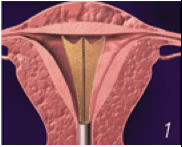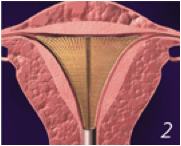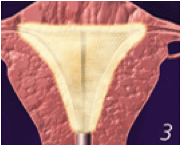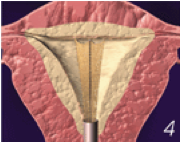Steps of the Novasure procedure

Under general or local anesthesia, a sheath containing the electrode (the part that does the ablation) is placed through the cervix. The sheath is pulled back, allowing the electrode (fan shape) to expand and conform to the shape of the uterine cavity.

The system inflates the uterus with a small amount of CO2 to ensure proper placement of the device.

The device is activated, and automatically turns off when it senses that treatment is complete. Usually this takes about 90 seconds.

After ablation is complete, the electrode safely retracts into the sheath for easy removal.
Most women are ready to go home within an hour after the procedure.
Advantages of the Novasure System
The Novasure System is the most rapid of all endometrial ablation techniques. FDA studies show that it has a high success rate and low complication rate. It can be done under local anesthesia (usually with sedation) or asleep. One of the risks of conventional ablation, the absorption of excess fluid, is eliminated. One of the biggest advantages is that no hormonal pretreatment is needed, and it can be done at any time of the menstrual cycle.
Disadvantages of the Novasure System
The size and shape of the uterus must be fairly normal in order to use the system. Fibroids or large polyps inside the cavity of the uterus will interfere with the placement of the device. In that situation, a resectoscope is first used to remove the fibroids or polyps, and then the ablation is performed. The Novasure system, however, is the only FDA approved device that was tested and found to be safe and effective in patients with smaller polyps, up to 2 cm, without having to first remove the polyps. It can also be used to treat a uterus that has fibroids as long as the fibroids do not distort of the shape of the cavity
